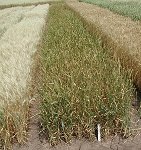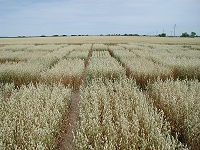

| May 31, 2002 |
 |
|---|
Matching up insurance and FSA office requirements in regards to planting and establishing this dryland cotton crop will be important. The counties last planting date will have to be considered. Lets say the last acceptable planting date is June 20, the producer that has poor soil moisture would want to wait until shortly before this date and plant. The producer has done what he can do to get a crop, the land was prepared correctly, planted to establish a stand, but the lack of moisture limited the opportunity to make a crop. If a rain happens to occur that was adequate enough to get germination but not enough to continue plant development, then it was planted correctly but since the last planting date is now past; the producer won't be required to replant. So match up both sides and follow the rules. Hopefully, we will get a rain and make a good crop--everyone benefits from that.
 Late in May, several counties received hail damage on grain sorghum and corn. Information on that topic is available in the factsheet "Assessing Hail and Freeze Damage to Field Corn and Sorghum (B-6014)".
Late in May, several counties received hail damage on grain sorghum and corn. Information on that topic is available in the factsheet "Assessing Hail and Freeze Damage to Field Corn and Sorghum (B-6014)".
Grain sorghum plants that were in the seven- to ten-leaf stage (depending on maturity group) will have to be evaluated closely. If the growing point was injured then a yield loss is a strong possibility. If the plants lost all of their leaf surface then it will have to be regenerated and this loss of time will probably result in yield loss also. The developing plant will have to contend with pollination during the hot and dry period of the summer and insect pressure generally is higher.

 A few of the wheat and oat tests made it to harvest this year. Counties with wheat plots remaining include: Callahan, Coleman, Concho, Jones, McCulloch and Runnels.
Just let me know when you want to thrash the hand harvested samples. If there are other counties that need to process samples, please let me know as soon as possible.
A few of the wheat and oat tests made it to harvest this year. Counties with wheat plots remaining include: Callahan, Coleman, Concho, Jones, McCulloch and Runnels.
Just let me know when you want to thrash the hand harvested samples. If there are other counties that need to process samples, please let me know as soon as possible.The wheat variety information is updated each year to reflect changes in disease and insect ratings in our region. A copy of this information is now posted at the following URL http://sanangelo.tamu.edu/agronomy/wheat/wht2002.htm.
The information covered at the CEA training on April 27 is now posted and available for your use in answering questions; the URL is http://sanangelo.tamu.edu/agronomy/forages/index.htm.
Shown are nine weeds that are developing in cropland and barditches at this time.
On June 10, there will be a training conducted at Abilene for producers needing to obtain a Private Applicators license. For more details and to register for the meeting call Gary Bomar at (915) 672-6048.
The annual cotton insect scout school will be held June 3, 2002 at the Texas A&M Research and Extension Center at San Angelo. If you would like to travel to south Texas to fine-tune your scouting skills, please contact Rick Minzenmayer at (915) 365-5212.
 June 3, Dist. 7 Headquarters, Insect Scout School
June 3, Dist. 7 Headquarters, Insect Scout School
 June 10 - 12, Brazos County, State 4-H Roundup
June 10 - 12, Brazos County, State 4-H Roundup
 June 18, Tom Green County, West Texas Dryland Institute Tour
June 18, Tom Green County, West Texas Dryland Institute Tour
 June 21, Tom Green County, Professional Ag Workers
June 21, Tom Green County, Professional Ag Workers
 June 27, Runnels County, Conservation Tillage Tour
June 27, Runnels County, Conservation Tillage Tour
 July 1, District 7 Office, Office Conference
July 1, District 7 Office, Office Conference
 July 2, Burnett County, Pesticide Training
July 2, Burnett County, Pesticide Training
 July 7 - 10, Nacogdoches County, TCAAA State Meeting
July 7 - 10, Nacogdoches County, TCAAA State Meeting
 July 15 & 16, Travis County, Texas 4-H Foundation Meeting
July 15 & 16, Travis County, Texas 4-H Foundation Meeting
 July 19, Tom Green County, Professional Ag Workers
July 19, Tom Green County, Professional Ag Workers
 July 28 - 30, Bexar County, TAEXSA State Meeting
July 28 - 30, Bexar County, TAEXSA State Meeting
Sincerely,
|